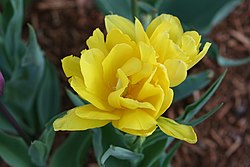Petal

A petal is a coloured part of a flower. With bright colours and scent, they often bring insects and birds to pollinate the flowers. Petals are made of cellulose and other organic matter.
Petals are modified leaves which surround the reproductive parts of flowers. Together, all of the petals of a flower are called a corolla.
The role of petals and the evolution of flowers is an important part of botany. It has been studied from the 18th century to the present day.[1][2]
The most common types of pollination are:
- Wind pollination: flowers are small and dull, with little or no scent, and often no petals at all. They produce large amounts of pollen which is scattered by the wind.
- Insect pollination: flowers show well in the ultraviolet range, and often have honey guides. These are lines leading from the petal to the nectar. Use of scent is also common.
- Bird pollination: large, colourful flowers with nectar.
References[change | change source]
Wikimedia Commons has media related to Petals.
